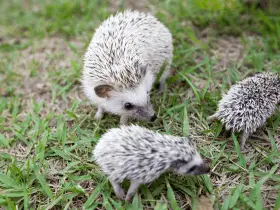We’ve got a wild one for you today, folks! Ever wondered why hedgehogs roll into balls? Well, get ready to dive deep into the fascinating world of these spiky creatures.
In this article, we’ll explore their anatomy, delve into their diet and hibernation habits, uncover the truth about those quills, and even touch on their role in mythology. Plus, we’ll throw in 15 other curious facts that will leave you amazed.
So grab a cuppa and join us on this adventure into the enchanting realm of hedgehogs!
Key Takeaways
- Hedgehogs roll into balls as a defense mechanism when threatened.
- The spines of hedgehogs serve as a form of protective armor against predators.
- Hedgehogs have the ability to self-anoint by spreading foam onto their spines.
- Hedgehogs primarily eat insects but also incorporate plant matter into their diet.
The Anatomy of a Hedgehog
Now let’s take a closer look at the anatomy of a hedgehog and see what makes them so unique.
Hedgehogs have fascinating features that contribute to their distinctive characteristics. One aspect to consider is hedgehog locomotion. Despite their small size, these creatures can move surprisingly quickly by using their short legs and strong muscles. They are adept climbers and can even swim when necessary, making them adaptable in various environments.
In addition to locomotion, hedgehogs possess remarkable sensory abilities. Their spines, which cover their backs, act as a defense mechanism against predators. When threatened or frightened, they curl into a tight ball, protecting themselves with these sharp quills. This behavior not only shields them from harm but also showcases another interesting feature: their ability to self-anoint. When encountering new scents or substances, hedgehogs will froth at the mouth and spread the foam onto their spines using backward head movements.
Overall, the anatomy of a hedgehog is incredibly well-suited for survival and protection in its natural habitat. Their impressive locomotion skills enable swift movement and adaptability to different terrains while their sensory abilities help ward off potential dangers.
These unique traits make hedgehogs fascinating creatures indeed!
Hedgehog Spines: A Defensive Mechanism
When it comes to hedgehogs, their spines are not just a fashion statement – they serve as a form of protective armor. These sharp quills act as a deterrent to potential predators, making it difficult for them to attack or swallow the hedgehog.
But have you ever wondered how these spines evolved over time? Let’s dive into the fascinating evolution of hedgehog spines and explore how they became such an effective defense mechanism.
Spines as Protective Armor
Imagine how painful it would be if you touched a hedgehog’s spines. But did you know that these spines have more than just a defensive purpose? Hedgehogs have evolved with these sharp spines as an ingenious way to protect themselves from predators.
Not only do the spines deter attackers, but they also serve as sensory organs. The evolutionary advantages of having spines go beyond protection. These prickly hairs allow hedgehogs to sense their surroundings and navigate through their environment. The spines are connected to specialized muscles that enable the hedgehog to control their position and movement, making them incredibly agile creatures.
Additionally, the spines play a role in communication between hedgehogs. When threatened or frightened, hedgehogs will roll into a tight ball, exposing only their spiky armor. This behavior signals danger to others and serves as a warning sign to stay away.
Evolution of Hedgehog Spines
The evolution of hedgehog spines has resulted in these prickly hairs serving multiple purposes, including protection and sensory perception.
Hedgehogs have developed unique adaptations over time to survive in their environments. Genetic variations have played a crucial role in shaping the diversity of hedgehog spines we see today. These variations influence the length, density, and flexibility of the spines, allowing hedgehogs to adapt to different habitats and predator threats.
For example, some species have longer spines that provide better protection against larger predators, while others have shorter spines that enable them to navigate through dense vegetation more easily. Additionally, these spines also serve as sensory organs, helping hedgehogs detect changes in their surroundings and locate prey.
Through evolutionary processes and genetic variations, hedgehog spines have become versatile tools for survival and exploration in their habitats.
Hedgehog Diet and Eating Habits
Hedgehogs primarily eat insects, but they will also consume small vertebrates and plants. Here are three interesting facts about hedgehog feeding patterns and their nutritional needs:
Insectivorous Diet: Hedgehogs are insectivores, meaning that insects form the majority of their diet. They have a natural instinct to hunt and feed on various types of insects such as beetles, slugs, worms, and caterpillars. This high-protein diet helps them meet their nutritional requirements.
Carnivorous Tendencies: While hedgehogs are mostly insectivores, they occasionally exhibit carnivorous behavior by consuming small vertebrates like frogs, mice, and baby birds. These additional sources of protein help in maintaining their energy levels.
Plant-based Supplements: Alongside their insect and vertebrate intake, hedgehogs also incorporate plant matter into their diet. They forage for fruits, berries, mushrooms, and even leaves to supplement their nutrition with vitamins and minerals.
Understanding the feeding patterns and nutritional needs of hedgehogs is crucial for providing proper care if you decide to keep one as a pet or encounter them in the wild. Remember to ensure a well-balanced diet that includes insects or commercial hedgehog food along with occasional animal protein supplements to promote good health in these adorable little creatures!
Hedgehog Hibernation: The Winter Sleep
If you plan on keeping a hedgehog as a pet, it is important to understand their hibernation patterns and how to ensure their safety during this winter sleep.
Hedgehogs are known to enter a state of hibernation when the temperature drops. During this time, their metabolism slows down significantly, allowing them to conserve energy and survive in harsh conditions.
The impact of hibernation on a hedgehog’s metabolism is remarkable. Their heart rate drops from around 190 beats per minute to only 20 beats per minute. This helps reduce their energy expenditure and allows them to survive without needing to eat or drink for extended periods.
Temperature plays a crucial role in hedgehog hibernation. As the temperature decreases, hedgehogs start searching for suitable places to hibernate, such as burrows or nests made from leaves and grass. It is essential that these locations provide enough insulation against the cold weather.
If you have a pet hedgehog, it is vital to create an appropriate environment for their hibernation period. Ensure that they have access to a cozy hiding place with plenty of bedding material like hay or shredded paper. Keep the room at a stable temperature between 65-75 degrees Fahrenheit (18-24 degrees Celsius) so that they can safely go into hibernation without any risks.
Understanding hedgehog hibernation patterns and providing the right conditions will help ensure your pet’s well-being during this crucial winter sleep period.
Hedgehog Communication and Vocalizations
When it comes to hedgehog communication, vocalizations and behavior play a crucial role. In order to understand how hedgehogs communicate, we will explore the different methods they use to convey their messages.
One fascinating aspect of hedgehog vocal patterns is the variety of sounds they can produce, from chirps and snorts to hisses and purrs.
Vocalizations and Behavior
One interesting fact about hedgehogs is that they communicate through a variety of vocalizations. These vocalizations serve as their primary means of communication and play a crucial role in their social interactions and behavior.
Here are three key ways hedgehogs use their vocalizations to communicate:
Purring: Hedgehogs emit a soft purring sound when they feel content or relaxed. This gentle vibrating noise signifies their comfort and happiness.
Snuffling: Hedgehogs make snuffling sounds when they are exploring their surroundings or searching for food. These snuffling noises help them navigate and locate potential prey.
Hissing: When hedgehogs feel threatened or fearful, they produce hissing sounds as a warning signal to deter potential predators. This aggressive vocalization serves as a defense mechanism to protect themselves.
Communication Methods Explored
Explore the various communication methods of hedgehogs, such as purring, snuffling, and hissing.
Hedgehogs rely on a combination of body language and chemical signals to communicate with each other and their environment.
When a hedgehog is content or feeling safe, it may emit soft purring sounds.
Snuffling is another way hedgehogs communicate by making sniffing noises to explore their surroundings and locate food.
However, if a hedgehog feels threatened or stressed, it may resort to hissing as a warning signal.
In addition to vocalizations, hedgehogs use their body language to convey messages. They can raise their quills when they feel threatened or curl up into a tight ball for self-defense.
Hedgehogs also leave chemical signals through scent marking, which helps them establish territory boundaries and identify potential mates.
Hedgehog Vocal Patterns
Now that we’ve explored the various methods hedgehogs use to communicate, let’s dive into their vocal patterns.
Hedgehog vocalizations are fascinating and play an essential role in their social interactions. Here are three intriguing facts about hedgehog vocal patterns:
Clicking: Hedgehogs produce a series of clicking sounds by rapidly moving their tongues against the roof of their mouths. This unique sound is often heard during courtship or when they feel threatened.
Snuffling: Hedgehogs make snuffling noises by inhaling and exhaling rapidly through their noses. This behavior is commonly observed when they are exploring new surroundings or searching for food.
Hissing: When hedgehogs feel defensive or agitated, they emit hissing sounds as a warning signal to potential predators or other hedgehogs invading their territory.
Understanding these vocal patterns helps us decode the complex language of hedgehogs and sheds light on how they communicate with one another in their natural habitats.
Hedgehog Vision and Hearing Abilities
Did you know that hedgehogs have excellent night vision and can see in almost complete darkness? It’s true! Hedgehogs possess a remarkable visual acuity that allows them to navigate their surroundings even when there is very little light available. Their eyes are adapted to low-light conditions, with large pupils that let in as much light as possible. This enables them to spot potential predators or prey while they are out foraging at night.
In addition to their impressive night vision, hedgehogs also have a keen sense of hearing. They can detect sounds within a wide range of frequencies, from 200 Hz all the way up to 45 kHz. This makes them well-equipped to pick up on the subtle sounds of insects rustling in the grass or the movement of larger animals nearby. Their acute hearing helps them locate food sources and avoid danger.
The combination of excellent night vision and sharp hearing gives hedgehogs an advantage in their nocturnal lifestyle. These sensory abilities allow them to thrive in various environments, from forests and gardens to urban areas. So next time you come across a hedgehog scurrying about at night, take a moment to appreciate its remarkable visual acuity and impressive hearing range.
Hedgehog Lifespan and Reproduction
If you’re considering getting a pet hedgehog, it’s important to know that their average lifespan is around 4 to 6 years. While they may not be with us for long, hedgehogs have fascinating mating habits and reproductive cycles. Here are three interesting facts about these prickly creatures:
Mating Habits: Hedgehogs are solitary animals but come together during the breeding season, which typically occurs from April to September. During this time, male hedgehogs will roam in search of females using scent markings and vocalizations to attract a mate.
Courtship Rituals: Once a male finds a potential mate, he will perform various courtship behaviors such as circling or head-jerking to impress the female. If she’s interested, she’ll respond by raising her quills and allowing the male to approach.
Reproductive Cycle: After successful mating, female hedgehogs undergo a gestation period of about 35 days before giving birth to a litter of hoglets. The average litter size ranges from one to seven hoglets, with an average of four or five being common.
Understanding these aspects of hedgehog reproduction can help you provide the best care for your pet if you decide to bring one into your home. Although their lifespan may be shorter than other pets, sharing your life with a hedgehog can be incredibly rewarding while they’re here with us.
Hedgehog Predators in the Wild
When it comes to the wild, hedgehogs have their fair share of predators. From foxes and badgers to owls and even domestic dogs, there are several natural enemies that pose a threat to these prickly creatures.
In order to protect themselves, hedgehogs have developed various defensive behaviors, such as rolling into a tight ball or making loud hissing sounds.
Understanding the dynamics between hedgehog predators and their survival strategies can provide valuable insights into the fascinating world of these unique animals.
Natural Hedgehog Predators
Be careful around foxes and badgers as they can be natural predators of hedgehogs. These creatures are known for their hunting habits and can pose a threat to hedgehogs in their natural habitat. Here are some important facts to keep in mind:
Foxes: They have keen senses and are skilled hunters. They often prey on small mammals like hedgehogs.
Badgers: These nocturnal animals dig burrows and are opportunistic feeders. Hedgehogs may become targets when crossing paths with them.
Natural Habitat: Hedgehogs typically reside in gardens, woodlands, meadows, and hedgerows where they find shelter and food.
Knowing about these natural predators helps us understand the challenges hedgehogs face in the wild. By being aware of their presence, we can take steps to protect these adorable creatures and ensure their safety in their natural environment.
Defensive Behaviors Against Predators
One way hedgehogs protect themselves from predators is by curling up into a tight ball. This defense mechanism, known as ‘self-anointing,’ helps them appear less vulnerable and more difficult to attack. When threatened, hedgehogs will tuck their head and limbs inwards, forming a spiky barrier that deters predators.
In addition to rolling into balls, hedgehogs also employ other self-defense techniques. For instance, they have sharp quills covering their bodies that serve as a deterrent against potential threats. Hedgehogs can also hiss loudly or make clicking sounds to scare away predators.
These defensive behaviors are essential for hedgehogs’ survival in the wild, where they face various natural adversaries such as foxes and badgers. While mating habits may differ among species, their ability to defend themselves remains crucial for their overall well-being and continued existence in their respective habitats.
Hedgehog Domestication: Pets or Not
Did you know that hedgehogs can make great pets if you’re willing to put in the time and effort to care for them properly? Here are some key tips for hedgehog training techniques, as well as hedgehog health and care:
Socialization: Hedgehogs need regular interaction with their owners to become comfortable and friendly companions. Handle them gently from a young age and provide opportunities for supervised playtime outside of their enclosure.
Litter Training: With patience and consistency, hedgehogs can be trained to use a litter box. Start by placing the litter box in a corner of their cage, filled with appropriate bedding material like paper pellets or recycled paper products.
Healthy Diet: A balanced diet is crucial to ensure your hedgehog’s well-being. Feed them high-quality commercial hedgehog food supplemented with small amounts of fresh vegetables, fruits, and insects. Avoid feeding them foods that are toxic or high in fat.
Properly caring for a pet hedgehog requires dedication, but it can be incredibly rewarding. Remember to consult with a veterinarian experienced in exotic animals for any specific concerns or questions about your furry friend’s needs.
Hedgehog Conservation and Threats
Hedgehogs are facing various threats to their conservation, including habitat loss and fragmentation, climate change, and predation by invasive species. These adorable creatures are in danger due to human interference with their natural habitats.
As our cities expand and more land is cleared for development, hedgehog habitat loss becomes a critical issue. The destruction of forests, hedgerows, and grasslands deprives hedgehogs of the shelter and food sources they need to survive.
Another major threat is habitat fragmentation. Hedgehogs require large areas to roam freely in search of food and mates. However, roads, fences, and other barriers disrupt their movement patterns and isolate populations from each other. This isolation can lead to reduced genetic diversity and make them more susceptible to diseases.
Climate change also poses a significant challenge for hedgehog conservation. Rising temperatures can affect the availability of food resources as well as disrupt hibernation patterns. Additionally, extreme weather events like droughts or floods can directly impact hedgehog populations.
Predation by invasive species further threatens hedgehogs’ survival. Animals such as badgers or foxes that prey on hedgehogs have been introduced into new environments where they compete for resources or directly hunt these spiky mammals.
To protect our beloved hedgehogs from these threats, it is crucial that we prioritize their conservation efforts through actions such as creating wildlife corridors to reconnect fragmented habitats and implementing measures to mitigate climate change impacts on their ecosystems.
Hedgehog Species Diversity
You can find a wide range of hedgehog species across different parts of the world, each with its own unique characteristics and adaptations. Here are some fascinating facts about these prickly creatures:
Hedgehog Mating Rituals: Hedgehogs have interesting courtship behaviors. The male will often perform a series of elaborate dances and vocalizations to attract a female mate. These rituals can vary between species but serve the same purpose of finding a suitable partner.
Habitat Preferences: Different hedgehog species have specific habitat preferences. Some prefer dense forests, while others thrive in open grasslands or even urban areas. This adaptability allows them to survive in various environments around the globe.
Unique Adaptations: Each hedgehog species has its own set of physical adaptations that help them navigate their chosen habitats. For example, the African pygmy hedgehog has longer legs and quills designed for climbing trees, while the European hedgehog has shorter legs and quills suited for digging burrows.
Hedgehogs are truly remarkable creatures with diverse mating rituals and habitat preferences. Understanding their unique characteristics and adaptations helps us appreciate their place in the natural world and fosters a sense of belonging among those who admire these adorable animals.
Hedgehog Quills: The Surprising Truth
Hedgehog quills, despite their appearance, are actually not sharp enough to cause harm to humans. These spines serve as the hedgehog’s primary defense mechanism against predators. They are made of keratin, the same material found in our hair and nails. Contrary to popular belief, these quills do not shoot out or detach from the hedgehog’s body.
Hedgehogs have around 5,000 to 7,000 quills on their back and sides. These quills grow continuously throughout their lives. As old ones fall out, new ones take their place. The growth rate varies depending on factors like age and health.
Grooming is an essential part of a hedgehog’s daily routine. They use their tongues to clean and arrange their quills, much like we brush our hair. This helps remove dirt and parasites that may get caught in between the spines.
While handling a hedgehog may seem intimidating due to its prickly exterior, with proper care and respect, it is possible to hold them without getting hurt. By supporting them properly from underneath and avoiding touching their sensitive belly area, you can enjoy interacting with these fascinating creatures while ensuring both your safety and theirs.
Understanding these facts about hedgehog quill growth and grooming habits allows us to appreciate these unique animals even more. Let’s continue exploring the intriguing world of hedgehogs together!
Hedgehog Behavior and Social Interactions
When it comes to hedgehog behavior and social interactions, there are several key points to consider.
First, we’ll explore their communication methods, which include a combination of vocalizations, body language, and scent marking.
Next, we’ll delve into the social hierarchy among hedgehogs and how they establish dominance within their groups.
Hedgehog Communication Methods
One way hedgehogs communicate is by emitting a series of high-pitched squeaks. These cute little creatures have their own unique methods of communication, allowing them to interact with each other and navigate their surroundings.
Here are three fascinating ways hedgehogs communicate:
Vocalizations: Hedgehogs use a variety of sounds to convey different messages. Their high-pitched squeaks can indicate excitement, distress, or even serve as a mating call.
Body Language: Hedgehogs also rely on body language to communicate. They may raise their quills when feeling threatened or curl into a ball to show submission or fear.
Scent Marking: Hedgehogs have scent glands that they use to mark territory and communicate with other hedgehogs in the area. They leave behind scents that act as signals for other hedgehogs.
Understanding these communication methods helps us appreciate the complexity of hedgehog social interactions and allows us to better understand and care for these adorable creatures who belong in our world.
Social Hierarchy Among Hedgehogs
Understanding the social hierarchy among hedgehogs will help you comprehend how they establish dominance and maintain order within their groups. Hedgehogs, like many other animals, have a complex system of social organization that determines their roles and relationships within a community.
Social hierarchy dynamics play a crucial role in shaping hedgehog behavior and interactions. In hedgehog communities, dominant individuals hold higher status and have privileged access to resources such as food and shelter. They often exhibit confident behaviors, such as raising their spines or making themselves appear larger, to assert their dominance over others. Subordinate hedgehogs, on the other hand, display submissive behaviors like curling up or avoiding direct eye contact.
Territorial disputes can arise when hedgehogs vie for limited resources or seek to establish their own territories. These conflicts are usually resolved through ritualized displays of aggression rather than physical confrontation.
Impact of Social Isolation
Being socially isolated can have a detrimental impact on our mental and emotional well-being. Humans are inherently social creatures who thrive on connection and interaction with others. The effects of social isolation on mental health are significant, and it is important to understand them in order to prioritize our social connections.
Here are three key effects of social isolation on mental health:
Increased risk of depression: Lack of social interaction can lead to feelings of loneliness and sadness, which can contribute to the development or worsening of depressive symptoms.
Poorer cognitive function: Socializing helps stimulate the brain, leading to improved cognitive abilities such as memory and problem-solving. Without regular social engagement, our cognitive function may decline.
Higher levels of anxiety: Social support plays a crucial role in managing anxiety. When we lack this support system, we may experience heightened levels of worry and stress.
It is essential that we prioritize maintaining social connections to safeguard our mental well-being and overall quality of life.
Hedgehog Mythology and Folklore
In hedgehog mythology and folklore, it’s believed that their ability to roll into balls symbolizes protection and defense. Hedgehogs have long been associated with symbolism in various cultures around the world. Their unique defensive mechanism of curling up into a ball has inspired stories and beliefs that highlight their resilience and adaptability.
According to hedgehog folklore, this ability to roll into a ball represents the hedgehog’s ability to protect itself from potential threats. It is seen as a symbol of self-preservation and defense against danger. In many legends, hedgehogs are portrayed as wise creatures who possess hidden knowledge and magical powers.
Hedgehog symbolism often includes themes of protection, independence, and resourcefulness. They are seen as guardians of secrets or keepers of ancient wisdom. In some cultures, they are even considered symbols of good luck and fortune.
The image of a hedgehog rolling into a ball has captured the imagination of people throughout history. It serves as a reminder that sometimes we need to protect ourselves from harm by embracing our own unique strengths and abilities. Just like the hedgehog, we too can find safety within ourselves when faced with adversity.
Hedgehog Popularity as Pets
If you’re considering a hedgehog as a pet, it’s important to understand their specific care needs and requirements. Hedgehogs have gained popularity as pets due to their unique appearance and low maintenance lifestyle. Here are some tips for taking care of your hedgehog:
- Provide a suitable habitat: Hedgehogs need a spacious cage with plenty of hiding spots and room to exercise.
- Maintain the right temperature: Hedgehogs prefer temperatures between 72-80°F (22-27°C), so it’s important to keep their environment warm and comfortable.
- Offer a balanced diet: Feed your hedgehog a combination of high-quality cat food, insects, fruits, and vegetables to ensure they receive proper nutrition.
Hedgehog breeding is another aspect to consider if you’re interested in expanding your furry family. Breeding hedgehogs requires careful planning and knowledge of their reproductive cycle. It’s essential to provide adequate space for the mother and her babies during the breeding process.
Remember that each hedgehog has its own personality, so spend time socializing with them daily to build trust and create a bond. By providing proper care, attention, and love, you can enjoy a rewarding experience with your hedgehog as a beloved pet member of your family.
Frequently Asked Questions
What Is the Lifespan of a Hedgehog?
Hedgehogs have an average lifespan of 4-7 years. They breed once a year and their life cycle consists of birth, growth, reproduction, and eventually death. Understanding their lifespan helps us appreciate their time with us.
What Are the Predators of Hedgehogs in the Wild?
Predators of hedgehogs in the wild are foxes, badgers, and owls. Understanding predator-prey interactions is crucial for hedgehog conservation efforts. It’s fascinating how these spiky creatures have adapted to protect themselves from their natural enemies.
Are Hedgehogs Considered as Pets?
Yes, hedgehogs are considered as pets. They have a unique diet and behavior that require special care. They can be engaging companions and provide a sense of belonging to those who choose to keep them.
What Are the Threats to Hedgehog Populations?
Hedgehog conservation is crucial due to threats like habitat destruction. We must protect their habitats to ensure their survival. It’s our responsibility as a community to come together and take action for the well-being of these adorable creatures.
Are There Different Species of Hedgehogs?
There are indeed different species of hedgehogs, each with their own unique characteristics. Our team has been actively involved in hedgehog conservation efforts to protect these fascinating creatures and ensure their survival.
Conclusion
In conclusion, we have unraveled the captivating world of hedgehogs and discovered some truly fascinating facts. From their intricate anatomy to their extraordinary spines, these little creatures never cease to amaze.
We’ve delved into their hibernation habits and learned about their unique communication methods. And let’s not forget the surprising truth behind those adorable quills!
Whether in mythology or as pets, hedgehogs have left an indelible mark on our hearts. So next time you see a hedgehog rolling into a ball, marvel at the wonder of nature’s tiny enchanters.















Leave a Reply
View Comments